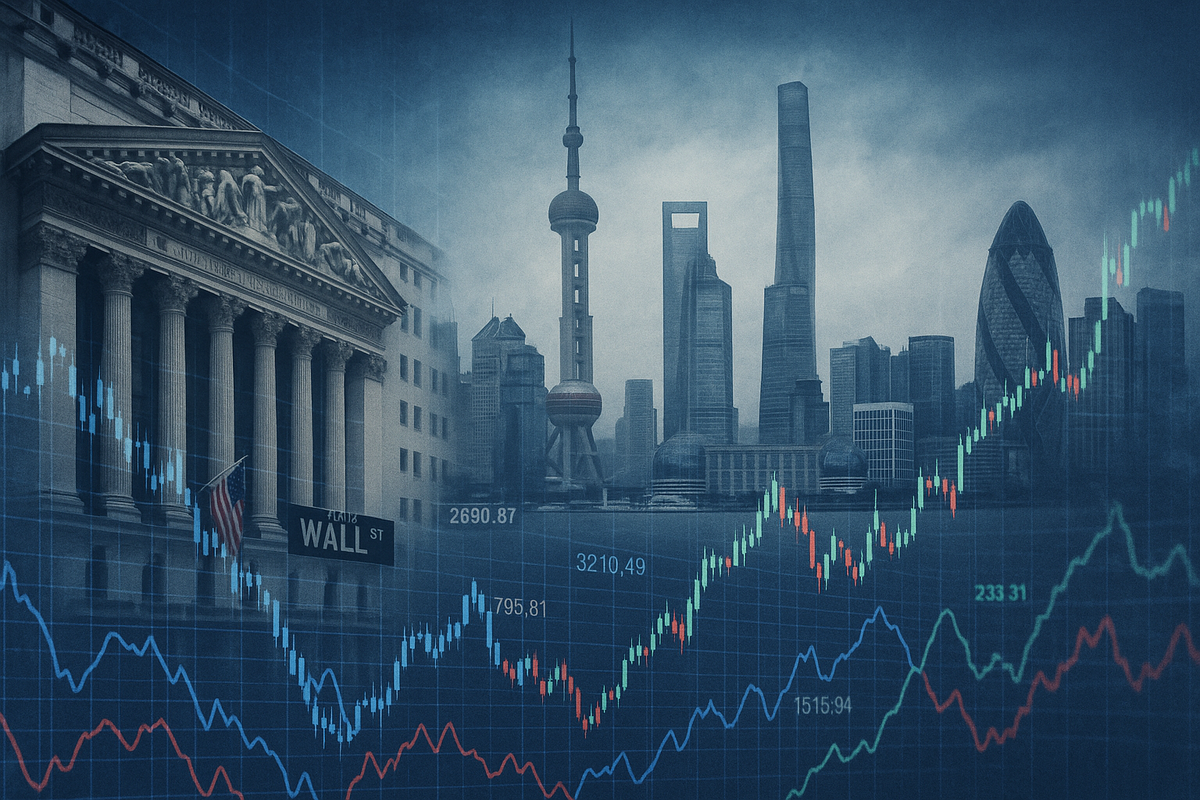
Global financial markets are currently experiencing a significant ripple effect from the trends observed in the United States, with a notable tech-led selloff on Wall Street sending tremors across continents. This interconnectedness has led to a general decline in major Asian indices, while European shares have exhibited a more mixed and nuanced performance, reflecting a complex interplay of global uncertainties and regional economic factors. The immediate implication is a heightened sense of caution among investors worldwide, as they closely monitor U.S. monetary policy signals and the ongoing re-evaluation of technology sector valuations.
Wall Street's Tech Rout Resonates Globally
The recent downturn in global markets is largely a direct consequence of a pronounced tech-led selloff that gripped U.S. equity markets in mid-August 2025. Both the Nasdaq Composite and the S&P 500 indexes recorded their sharpest declines since early August, primarily driven by a significant rout in major technology firms. Companies such as Nvidia (NASDAQ: NVDA), Palantir (NYSE: PLTR), and Oracle (NYSE: ORCL) bore the brunt of this downturn, as investor unease grew over the sustainability of a prolonged rally in tech stocks and fresh doubts emerged regarding the artificial intelligence (AI) boom's immediate prospects. This de-risking sentiment was further amplified by anticipation surrounding Federal Reserve Chair Jerome Powell's upcoming remarks on interest rates at the Jackson Hole symposium, prompting investors to pull back from riskier assets.
The timeline leading up to this moment saw a period of robust growth in tech stocks, fueled by optimism surrounding AI advancements and strong earnings reports from several industry leaders. However, concerns about overvaluation and the potential for a hawkish stance from the Federal Reserve began to mount, culminating in the recent selloff. Key players involved include major institutional investors, hedge funds, and retail traders, all reacting to shifting market sentiment and macroeconomic indicators. Initial market reactions globally were swift, with Asian markets immediately reflecting Wall Street's overnight losses, while European markets showed a more varied response, attempting to balance global pressures with local economic data and corporate earnings.
Tech Giants Face Headwinds, While Diversified Portfolios Seek Stability
The current global market scenario, marked by a tech-led selloff in the U.S. and mixed performances across Asia and Europe, is creating a clear divide between "winners" and "losers" in the financial landscape. Growth-oriented technology stocks, particularly those with high valuations and speculative AI plays, are facing significant headwinds. Companies like Nvidia (NASDAQ: NVDA), AMD (NASDAQ: AMD), and Palantir (NYSE: PLTR) have seen substantial stock price drops, with Nvidia experiencing its largest single-day loss in nearly four months. The broader "Magnificent Seven" tech stocks, including Tesla (NASDAQ: TSLA), Meta Platforms (NASDAQ: META), Alphabet (NASDAQ: GOOGL), Amazon (NASDAQ: AMZN), and Apple (NASDAQ: AAPL), have also been under pressure. This is largely due to concerns about overvaluation, the impact of rising interest rates on their future earnings, and a "cooling" of the initial AI enthusiasm. Startups, too, are struggling with increased borrowing costs and restricted credit availability, leading to declining valuations. Retailers, such as Party City, Tupperware, Red Lobster, and Rite Aid, are also facing difficulties due to inflationary pressures and reduced consumer spending, with some even refiling for bankruptcy.
Conversely, defensive sectors and those benefiting from specific regional trends are showing resilience and even outperformance. In the U.S., utilities, consumer staples, and Real Estate Investment Trusts (REITs) are attracting capital due to their predictable cash flows and dividend yields, making them attractive in a high-rate environment. The energy sector, with companies like Exxon (NYSE: XOM) and Chevron (NYSE: CVX), is staging a comeback as a natural inflation hedge. Industrials and healthcare are also seen as resilient. Notably, Home Depot (NYSE: HD) has gained due to solid housing demand, and Intel (NASDAQ: INTC) surged after a significant investment from SoftBank. Luxury travel company Viking Holdings (NYSE: VIK) is demonstrating sustainable growth, while insurers like Beazley (LON: BEZ) are benefiting from higher interest rates.
In Europe, attractive valuations and improving economic prospects, including lower inflation and potential interest rate cuts by the European Central Bank (ECB), are driving strong performance. Defense companies, such as Rheinmetall (ETR: RHM), are seeing a tailwind from increased defense spending. Industrial goods, healthcare, banks, and utilities are also performing well. Certain consumer discretionary companies like LVMH (EPA: MC), Kering (EPA: KER), Stellantis (NYSE: STLA), and Mercedes-Benz (ETR: MBG) have also seen gains. Asia presents a mixed picture, but opportunities exist in China's consumption, energy, and healthcare sectors, and India's banking and IT services. Taiwan and Korea are expected to see robust earnings growth in AI-related technology, particularly semiconductors. Japan's equity market rally may broaden to mid-to-small cap stocks, and Vietnam is poised for strong market returns.
Broader Implications: A Shift Towards Value and Resilience
The current global market trends are not merely a fleeting reaction to U.S. market movements; they represent a significant shift within broader industry landscapes, with profound ripple effects on competitors, partners, and regulatory frameworks. This period is characterized by a re-evaluation of growth-oriented assets, particularly in the technology sector, and a renewed focus on value and resilience.
This event fits into a broader industry trend of digital transformation and technological advancements, where AI and machine learning are revolutionizing business models. However, the recent tech selloff highlights a growing discernment among investors, moving beyond speculative enthusiasm towards a demand for tangible profitability and sustainable growth from these innovations. This could lead to a consolidation within the tech sector, where smaller, less profitable startups may become acquisition targets for larger, more established tech giants, or simply struggle to compete. Companies that lag in AI adoption may find themselves at a significant disadvantage. Conversely, strategic alliances and new market penetration, especially in emerging economies, could offer avenues for growth for agile businesses.
Regulatory and policy implications are also significant. The rapid pace of technological advancement, particularly in areas like data protection and digital currencies, is challenging regulatory bodies to develop robust yet flexible frameworks. There's an increasing emphasis on environmental regulations, pushing businesses towards more sustainable practices. Furthermore, regulatory or legislative changes are identified as a top global risk, as new laws and rules can substantially reshape the business environment, affecting operational costs and market dynamics. Geopolitical shifts and a global trend towards "country-first" policies could also lead to increased protectionism and fragmentation in global trade, potentially resulting in slower growth and higher inflation in some regions.
Historically, these market dynamics echo past financial crises and technological revolutions. The current tech selloff draws parallels to the dot-com bubble burst of 2000-2002, where overvalued tech companies experienced significant corrections. Similarly, the interconnectedness of the global economy, as seen in the 2007-2008 financial crisis, underscores how events in one major market can quickly cascade worldwide. The current shift in market dominance, with European and Asian markets showing resilience or even outperformance compared to the U.S., could be a secular trend, reminiscent of periods when a wide performance and valuation gap existed between domestic and international markets. Central bank actions, particularly interest rate adjustments, remain a crucial factor, as seen throughout history in managing economic conditions.
Navigating the Shifting Sands: What Comes Next
The path forward for global markets is characterized by a complex interplay of economic, geopolitical, and technological forces, demanding adaptability and strategic foresight from investors and businesses alike. In the short term (2025), a modest global growth rate of around 3% is projected, with the U.S. economy anticipated to achieve a "soft landing" despite delayed interest rate cuts. This period will likely see a divergence in regional performance, with some smaller economies and parts of Europe accelerating, while China's underlying economy remains soft, albeit with expected fiscal support. Investors are already reallocating capital from U.S. equities to overseas markets, particularly Europe, Asia (India, South Korea, Taiwan), and Latin America, driven by widening valuation gaps and more compelling risk-adjusted returns. Continued market volatility is expected due to ongoing policy uncertainty and geopolitical risks.
Looking further ahead, the long-term possibilities suggest a sustained period of low global growth, with forecasts around 3.1% five years from now. A baseline scenario points to continued fragmentation of the global order, leading to gradual economic decoupling and declining growth rates as financial intermediation becomes more complex. Demographic shifts, such as an aging global population and increasing urbanization, will continue to reshape consumer and financial markets, requiring new approaches to products and services. Climate-related risks and opportunities will also intensify, necessitating ongoing adaptation solutions and investments in green technologies.
To navigate this evolving landscape, strategic pivots and adaptations are crucial. Businesses and investors will need to adopt new mindsets, decision models, and business models, embracing agility and flexibility to respond quickly to market changes. Diversification across different asset classes, sectors, and geographies will be key to mitigating risks and capturing opportunities. Leveraging advancements in artificial intelligence and machine learning can provide valuable insights for data-driven decisions. Companies should also reassess their reliance on specific markets and diversify into new consumer markets to mitigate risks associated with trade tensions and policy uncertainties. The focus will increasingly be on resilience, with companies adopting asset-light models and focusing on robust segments like luxury travel.
Market opportunities will emerge in emerging markets like India, South Korea, Taiwan, and Latin America, driven by technology exports, domestic consumption growth, and infrastructure spending. Demographic niches, such as the aging population and the increasing wealth of women aged 60+, present significant opportunities in sectors like luxury goods, insurance, education, and healthcare. The green energy and sustainability sectors are also poised for significant growth due to policy support and private funding. Despite potential volatility, the technology sector, particularly in AI, continues to show strong earnings and growth. However, challenges persist, including heightened geopolitical tensions, inflation and interest rate volatility, supply chain fragility, and trade protectionism. Regulatory and policy uncertainty, along with currency fluctuations, will also continue to impact international trade and investment.
A New Era of Discerning Investment
The recent global market movements, mirroring the tech-led selloff in the U.S. and the subsequent mixed performance across Asia and Europe, underscore a pivotal moment in the financial landscape. The key takeaway is a shift from a period of broad-based growth, particularly in the technology sector, to one demanding more discerning investment strategies. Investors are increasingly prioritizing value, resilience, and tangible profitability over speculative growth, prompting a re-evaluation of portfolios and a rotation into defensive sectors and geographically diversified assets.
Moving forward, the market will likely remain characterized by volatility and regional divergence. While the U.S. economy aims for a soft landing, the global economic picture will be shaped by ongoing geopolitical tensions, inflationary pressures, and the evolving impact of technological advancements. The interconnectedness of global markets means that events in one major economy will continue to have ripple effects worldwide, necessitating a vigilant approach to investment.
The lasting impact of this period will likely be a more fragmented global order, with increased emphasis on localized supply chains and a greater focus on sustainable and ethical business practices. Investors should watch for continued shifts in capital allocation towards emerging markets and sectors benefiting from long-term demographic and climate-related trends. The ability of central banks to manage inflation without stifling growth will be paramount, and any unexpected policy shifts could significantly impact market sentiment. Ultimately, success in the coming months will hinge on adaptability, diversification, and a deep understanding of the nuanced dynamics shaping the global financial landscape.





